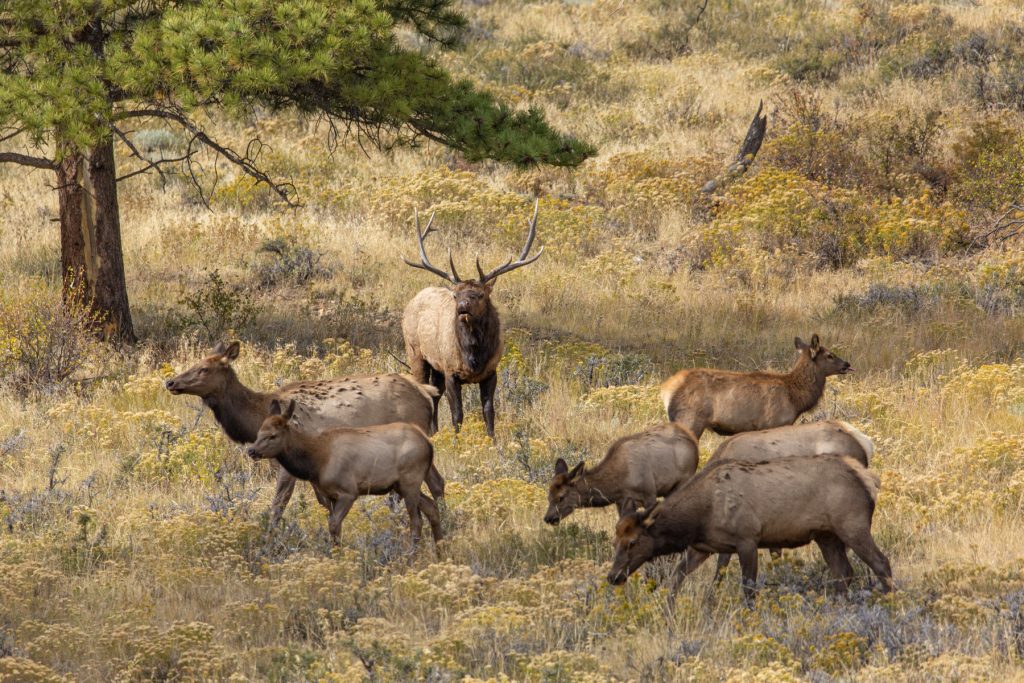
MODULE 17 - HUNTING COW ELK
CHAPTER 1: YOU CAN'T EAT THE ANTLERS

WHY HUNT COW ELK?
The real question here is ‘Why NOT hunt cow elk?’ Antlerless hunting opportunities are plentiful, and in many states, the number of cow elk tags offered far outnumbers the quantity of antlered hunts that are available. Additionally, when it comes to population demographics, with very few exceptions, there are going to be far more cow elk in an area than bull elk. Plus, when it comes to filling the freezer, well, you can’t eat the antlers!
MORE OPPORTUNITY
States often manage their elk herds using a handful of important metrics, including overall population and bull-to-cow ratios. A healthy statistic in each of these categories will often provide a sustainable – and huntable – population of elk for years to come. And through that management, there is typically a greater number of cow elk than bull elk – which often leads to an offering of more antlerless hunting opportunities.
Here are just a few examples of antlerless elk hunting opportunity compared to antlered elk:
Idaho
- In 2019, 9017 bull elk were harvested during General/OTC hunts. 4784 antlerless elk were harvested during the same hunts.
- In 2019 Controlled (limited draw) Hunts, 3690 antlered tags were issued to 39447 1st choice applicants (draw odds of 9.35%). 9545 antlerless elk tags were issued, with only 18843 1st choice applicants (draw odds of 50.66%)!
- Several “extra antlerless tags” are also available, as well as several additional “either-sex” opportunities.
Wyoming
- General Elk license allows you to hunt archery and rifle season – and many units allow hunters to harvest any elk (bull or cow). It is “draw only” for non-resident elk hunters in WY, but the odds of drawing are not too bad.
- Several Draw Hunts (Type 4/5 Full Price, Type 6/7 Reduced Price)
- Type 4 and 5 Full Price Antlerless Hunts use your preference points if you draw one of these hunts as your 1st choice, but not if you draw the hunt as your 2nd choice. In 2019, there were 396 antlerless tags available in these hunts and only 130 1st choice applicants! The remaining 266 antlerless Type 4/5 tags went to 2nd choice applicants, of which there were only 748 (36% draw odds as 2nd choice).
- Type 6/7 Reduced Price antlerless elk tags in Wyoming do not use up your preference points if you draw. In 2019, there were 3119 tags available and 4703 1st choice applicants (66% draw odds). Additionally, you can apply for both tag types (Type 4/5 AND Type 6/7), and draw both tags! Non-resident applicants could also apply for a Full-Price Bull Elk tag AND a reduced price (type 6/7) cow tag!
- There are 97 antlerless controlled hunts (Full Price) in Wyoming, and in 2019, 86 of those hunts were 100% for 1st choice applicants. And 51 of those were 100% as 2nd choice!
Well, what about the states that manage for big bulls? What are the antlerless opportunities there?
Arizona
- In 2019, Arizona issued 12,074 antlerless tags, with 28,865 applicants – 42% draw odds. On the other side of the coin, they also issued 12,606 bull tags, with 89,412 applicants – 14% draw odds. Plus, most of the bull tags issued were in late season hunts with low success rates.
- If you want to experience the elk rut, or hunt one of the best elk units in Arizona, it’s possible and a lot easier than you might think.
- Example: Arizona, Unit 10 – In 2019, there were 40 rifle tags for bull elk in unit 10 during the rut…and 5537 applicants (your draw odds would be less than 1%). For a cow tag in the same unit during the rut, there were 725 tags and 955 applicants (76% draw odds)! For late season hunts in the same unit, there were 350 bull tags and 1399 applicants. During the same season – 749 cow tags and only 407 applicants!
Many states allow you to harvest “any elk” during their general/OTC seasons. Draw odds in states that have limited antlerless hunts are often 5-10X better than bull tags in the same unit, and many are 100%!
As you can see, opportunity abounds, and the ability to acquire these antlerless tags is often MUCH easier than acquiring a bull elk tag.
In states where most of the tags are distributed through a controlled draw, antlerless hunting opportunities usually take far fewer years to draw the tag. A resident of a state where this is the case may be able to hunt cow elk every year, while a bull elk tag in the same area might take 20+ years to draw.
HERD DEMOGRAPHICS
The ease of getting an antlerless elk tag isn’t the only benefit of hunting cow elk. Most states have a “target” bull-to-cow ratio – a ratio that provides a certain number of bulls for every 100 cows to maximize the efficiency of breeding and the harvesting of bull elk.
States that manage for bigger bulls and better rut hunting experiences often have higher bull:cow ratios as they limit the number of bulls that can be shot. For example, Arizona manages for an average bull:cow ratio of 35:100, with some units approaching 100 bulls for every 100 cows. Overall, there is still an average of 3X as many cows as bulls in Arizona.
In OTC/General elk hunting states like Idaho, Wyoming, Colorado – you’ll often find bull:cow ratios of 20+ bulls per 100 cows, meaning there are 5-6X as many cows as bulls in many units. This equates to a target-rich environment if you are an antlerless elk hunter!

Aside from more opportunity and more targets, you can still hunt your preferred season in most states (archery, ML, rifle, early, general, late, etc.). Additionally, if you want to experience the full thrill of the elk rut in some of the best units in the west, you can do so – with an antlerless tag in tow!
ORGANIC PROTEIN
Lastly, it’s hard to beat the taste of elk meat, bull or cow. But old-timers will argue that there is nothing better than a young cow elk for the freezer!
But, before we get too excited here, let me point out that hunting a cow elk will not likely be any easier than hunting a bull. In fact, a wise old cow is sometimes the only thing that keeps a rut-crazed bull alive during the rut! It is often the cows that keep vigilant watch on the herd, and you’ll rarely find a cow elk letting her guard down due to the rut – or any other factor.
Before we jump in and start talking about specific strategies for targeting cow elk, be sure you have thoroughly studied the content in Module 6 on Elk Hunting Knowledge. There is information in that Module that applies to this Module for sure, especially as we talk about the yearly habits of elk (calving, summer range, rut, migrations, winter grounds, etc.). Additionally, it would be worthwhile to go back through Module 15: Late-Season/Post-Rut as well, paying particular attention to the needs of elk. The information in those 2 Modules will be vital to fully understanding and applying appropriate tactics for hunting antlerless elk.
Click ‘Next Chapter’ Below to Continue to Chapter 2: How to Hunt Cow Elk





